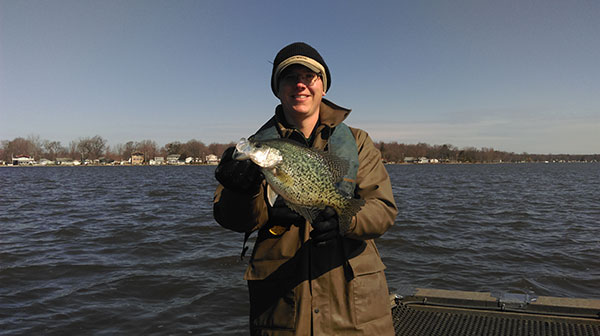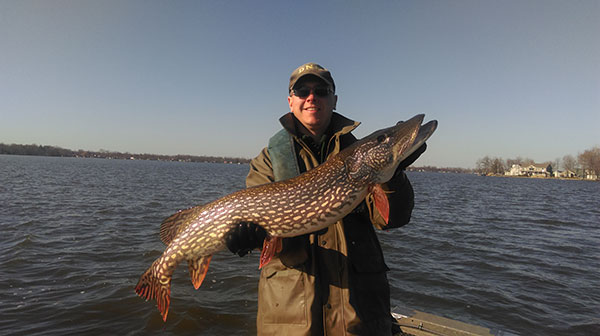Biologists Offer Snapshot of Area Lake Populations
By Louie Stout
 Biologists Offer Snapshot of Area Lake Populations
Biologists Offer Snapshot of Area Lake Populations
About the time most anglers were having dinner earlier this year, Indiana district fish biologists were launching their research boats and going to work.
Late spring and summertime lake surveys are a big part of the job for fish managers and Indiana DNR District Biologist Tom Bacula is no exception. He and his assistant have spent a lot of time on area lakes doing routine assessments of fish populations.
These surveys are done with either nets or a shock boat that idles near shorelines with electric probes dangling into the water. The generator-powered volts are just enough to stun fish and bring them to the surface. They are netted, counted, measured and a few scale samples are scraped from their sides before they are returned safely into the lake.
Bacula has surveyed several lakes this summer and his preliminary results show Fish Lake near Walkerton might be the best, especially for panfish.
Fish Lake consists of two sections, Upper and Lower Fish. They combine for 273 acres.
While we were there, we captured 494 bluegills, 265 of them were up to 9 inches and there were a lot over 7 inches, offered Bacula. We saw some nice warmouth and big redear, too. The perch we found were small, but perhaps in a couple of years fishing will be good for them, too.
The numbers werent quite as good on lower Fish Lake, but the researchers still saw a lot of nice bluegill and redear.
On the downside, bass numbers were low and the fish they saw were small.
Fish Lake is a bluegill lake, said Bacula. The size structure of gills is very good for a lake that gets a lot of fishing pressure.
Here are some of his observations on other lakes surveyed:
Bass Lake: I dont know who named that lake, but its far from a good bass lake and is best known for the walleye that the state plants there.
However, walleye numbers of small fish werent as high as biologists expected when they were there but the fish they did encounter looked healthy.
We saw several good looking walleye and we even came across some pike that we didnt know were there, Bacula said. Wed heard rumors of pike in the past but weve never captured or seen any during our surveys, and were out there a lot.
 One pike they caught was 38 inches, estimated to weigh in the upper teens.
One pike they caught was 38 inches, estimated to weigh in the upper teens.
One pike they caught was 38 inches, estimated to weigh in the upper teens.
The biologist also came across some nice crappie in the lake but not the quantity he hoped to see.
Bass Lake is a relatively shallow lake covering nearly 1,350 acres. Its located 6 miles south of Knox, Ind. in Starke County.
Hog Lake: This little kettle lake (59 acres) located 2½ miles north of Rolling Prairie is ringed with vegetation and a big portion is a wetland.
Biologists didnt come up with a lot during their brief survey, but Bacula said its not a lake that sets up well for his electro-fishing equipment. The probes are only good down to 6 feet and they couldnt get near shore because of the vegetation.
The bluegill we saw werent bad and the big surprise is we found two redear over 8 inches, Bacula said.
He did encounter some nice bass one pushing 22 inches and two over 20. Sounds like a good lake to fish with a rubber frog over the weeds or pitch worms and jigs into the holes this summer.
Koontz Lake: Koontz has had a big bass reputation for years but Bacula didnt encounter any when he was there the second week of June.
The water temperature was pushing 80 degrees which means there probably werent many bass prowling the shallows.
The bluegill we saw looked pretty decent, Bacula said. Nothing big, but a nice grouping of 6 inchers and bigger. We also saw a fair amount of perch and some white bass.
The biologist said they rolled some really nice catfish, too.
The best news is the vegetation is starting to recover, he said. We saw a fair amount of native plants.
Koontz plant life was nuked a few years ago in a lake association attempt to kill off the milfoil.
Millpond/Kreighbaum: The adjoined, 168-acre Plymouth area lakes turned up a lot of bluegills, redear sunfish and their hybrids ranging from 7 to 9 inches. Bacula said crappie numbers were pretty good, too.
Hudson Lake: Wouldnt you know that a Hudson Lake survey would turn up good results now that the lakes best access a private ramp once open to the public - was lost in a land sale last winter. You can still launch off a public beach but parking is tough and its not ideal.
You may have read a few months ago how the Indiana DNR screwed up a golden opportunity to buy the property that could have served anglers and waterfowl hunters. DNR management was informed of the need from anglers and the previous landowner offered it to the state.
DNR officials in Indianapolis refused to even try to make a deal, pleading funding issues.
Anyway, Bacula says the bluegill and redear in the lake are excellent size and local people are excited about the fishing there.
Most of the bluegill were 8-9 inches and the redear were as big and as nice as any Indiana lake Ive seen, he said. Crappies were ok, but there was a nice age group. The biggest surprise was the number of nice bullhead catfish we captured.
Its a shame that DNR management dropped the ball on a nice lake that historically has produced good fishing.





